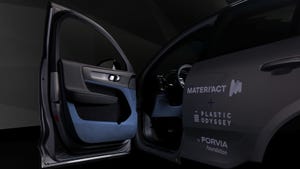A technology initially developed to absorb impact in running shoes now protects soldiers, seeing use in everything from helmets and kneepads to blast-limiting sheets and seat cushions, with development of ballistic grades for vests currently under way.How much protection? During an interview with Mike Buchen, president and CEO of Skydex, at its Centennial, CO headquarters, he covered one hand with the company’s new thermoplastic polyurethane (TPU) sheet padding and used the other to repeatedly slam a ballistic helmet into the material. This reporter was convinced.
March 1, 2010
A technology initially developed to absorb impact in running shoes now protects soldiers, seeing use in everything from helmets and kneepads to blast-limiting sheets and seat cushions, with development of ballistic grades for vests currently under way.
How much protection? During an interview with Mike Buchen, president and CEO of Skydex, at its Centennial, CO headquarters, he covered one hand with the company’s new thermoplastic polyurethane (TPU) sheet padding and used the other to repeatedly slam a ballistic helmet into the material. This reporter was convinced.
The key to its innovation is what Skydex calls twin hemispheres. Supplied in sheet form, the product is made by forming small cups, or hemispheres, in a TPU sheet, and then joining two still-warm sheets of the structures in a twin-sheet thermoforming process, so that the cups are bonded together, bottom to bottom, to form an hourglass shape.
By changing the hemisphere’s composition, thickness, and spacing, Skydex can tune them to a specific function, with current applications covering blast limiting, cushioning, impact mitigation, vibration absorption, and sound dampening. The product also uses various additive packages to boost functionality and performance in the field, including the addition of flame-retardant, anti-mildew, anti-fungus, and anti-static systems.
At the company’s headquarters, Buchen and Peter Foley, chief technology officer, walked through the numerous applications the unique geometry has found a niche in, pulling product samples off the wall of their conference room, and occasionally demonstrating their effectiveness. With the ability to target foam currently used for cushioning and protection, the potential volume of applications for the technology seems limitless, but Foley said Skydex has maintained strict focus in the products it targets.
“We’re not packaging foam,” Foley explains. “We have to protect things that matter, because if it’s something that can be broken and replaced, you’re probably going to protect it with polystyrene or something like that. For now, there are so many different ways we can tune this to protect brains and limbs, that that’s really the focus.”
Part of that immediate winnowing of development is blast-limiting panels that will be included in more than 6000 military vehicles headed to Iraq and Afghanistan. Force Protection’s Cougar and Buffalo vehicles, as well as Oshkosh’s M-ATV, will feature large sheets, up to 60 by 90 inches, to help mitigate the impact caused by improvised explosive devices (IEDs).
Using independent studies, Skydex determined that its protective material reduces blast force transmitted through the floor by 71%. Those results were for vehicles headed to Afghanistan, where roadside bombs cause 75% of the casualties to coalition forces, and more than 50% of the troops will be exposed to a blast wave in one form or a another.
“We really started focusing on the military in 2004,” Foley says, “and re-engineered the technology from dealing with the impact of a foot hitting the ground, which is a very known thing, to protecting brains from bullets, protecting brains from overpressure, shockwaves, IEDs.”
Building better helmet padding
Before it was placed on the floors and walls of the next generation of vehicles to be deployed in Iraq and Afghanistan, Skydex’s first tour came in ballistic helmets, replacing leather headbands. The older-generation PASGT system, which used leather or Kevlar to hold a helmet on, had proven uncomfortable, and the next-generation foam pads failed to perform under all the conditions soldiers can face. Buchen recalls a sales call in which, after storing the foam pads in a small cooler so they came down to 35-40°F, he broke them in half at a National Guard base. Because of this lack of low-temperature performance, troops were instructed to remove the pads from their helmet at night in cold environs and store them in a warm place.
After adopting Skydex’s twin hemispheres, the Army has more than doubled the impact standards for its helmet pads because of their properties, taking them from absorbing 10 ft/sec of impact velocity to now striving for 17 ft/sec.
A duty to their customers
The choice to protect soldiers in the field as opposed to flat-screen TVs during shipping has had numerous impacts on Skydex, including how it deals with certain customers. “We are committed to protecting things that matter and in this business, I don’t know of anything that matters more than the safety of our men and women in uniform,” says Buchen. —Tony Deligio
About the Author(s)
You May Also Like


